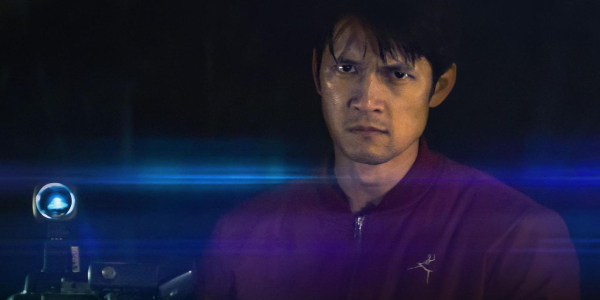SXSW 2021: HERE BEFORE, THE SPINE OF NIGHT, & BROADCAST SIGNAL INTRUSION
You can always count on SXSW to deliver some thrillers that, through their low-budget limits, find a new style or storytelling form to stand out. Here Before provides the creeps with an extra layer of grief, The Spine of Night throws fantasy genre conventions out the window by embracing cosmic horror elements, and Broadcast Signal Intrusion tackles a niche but skin-crawling subject matter that is rarely found in movies. All three are worth a look for their unique and committed approach to their respective genres.
Here Before (Stacey Gregg): Creepy Direction and Performances Hold Off an Underwritten Plot
It ain’t SXSW without having psychological mind games in its lineup, and this year we are greeted with one led by Andrea Riseborough, who has held quite the track record for thrillers in the past few years.
Here Before is an exercise in stretching out tension and creepiness with a small setting and a simple script. Laura (Riseborough) is still grieving over the death of her daughter, and reality and dreams begin to blur when a new family moves in, whose daughter Megan manages to turn up some uncomfortably accurate memories that only Laura would know about.

With a premise this simple, the film does deserve credit and praise for how much suspense writer and director Stacey Gregg was able to get within 83 minutes. At the same time, the script is saddled with a simple “Is she or is she not crazy?” question. With the budget low and the locations fixed, there isn’t much room for subplots or deeper thematic explorations. Really, the only thing that drives Here Before forward is this mystery, and once the arguably underwhelming answer is revealed, the film has only about five minutes left to wrap up.
Along the way, Here Before remains interesting, thanks to Riseborough’s tremendous and vulnerable performance, beautiful cinematography, and some unsettling song choices. The film takes a while to get going, but the tension eventually picks up and it’s might just be enough to hold your attention from start to finish.
Here Before premiered at SXSW on March 17, 2021.
The Spine of Night (Philip Gelatt and Morgan Galen King): Crazy, Violent, and A Lot to Take In
One of my favorite aspects of animated films is that I can always watch one with a clear voice in my head, reminding me that people actually drew it. The Spine of Night takes that aspect one step further by choosing what is perhaps the most painstaking method in the medium – rotoscope animation. From start to finish, you will be constantly aware of the hard work the animators went through to put this ua-violent fantasy together. And let me be absolutely clear: This movie is ua-violent, not to mention batshit crazy.
Aside from adult animated fantasies from the 80s that clearly inspired this film, there is no other work of animation today like The Spine of Night. It throws nearly all genre conventions out the window and finds that blurred line where fantasy becomes surreal cosmic horror. The end result is something I can only describe as “Skyrim on edibles.”

At first, the film is a lot to take in. It doesn’t bother explaining its world-building and rules to us, and the narrative isn’t always clear chronologically. We’re left to just absorb a series of moments, and the context of what’s happening and what’s driving character motivation is very much limited. Even though the overarching story does involve an evil man consuming a powerful source of magic called The Bloom and the rest of civilization attempting to stop him, the script itself isn’t always upfront with us on which part of the story we are at. We only get to see fragments. For a while, it could feel like walking into a fan club for something you’ve never seen and you’re constantly trying to play catch-up.
Eventually, however, when the film gets to a specific part where Richard E. Grant‘s character tells a story, the film suddenly becomes riveting to watch. It feels like the universe of The Spine of Night just experienced a Big Bang and we are given the privilege to watch it expand in front of our eyes. It’s weird, unrestrained, and beautiful.
Behind every bit of the ua-violent rotoscope animation is a watercolor painting of a backdrop, each one beautiful yet intimidating enough to be on a prog metal concept album cover. In fact, another fun way to watch this movie is to mute it and have it serve as a music video to whatever heavy metal music you want to listen to. Once The Spine of Night gets to its final thirty minutes, I was completely on its wavelength and was willing to accept whatever writers/directors Philip Gelatt and Morgan Galen King wanted to show me.
Not only is The Spine of Night worth a look just by how it bends its genre, but this is also worth watching as a live-action epic. Despite me complaining about its lack of interest in explaining things, I do believe that this world has enough lore and history to develop a cult following. Not only is this a world I want Gelatt and King to return to, but it’s also a world that I hope some mainstream studio out there is batshit crazy enough to fund a big project for.
The Spine of Night premiered at SXSW on March 18, 2021.
Broadcast Signal Intrusion (Jacob Gentry): Weak in Plot, Strong in Atmosphere
The very premise of Broadcast Signal Intrusion is one that I too have somewhat of an obsession over. If you’re at all familiar or experienced in navigating through “the weird side of YouTube,” this film will probably jog some memories.
Essentially, our protagonist is a video archivist named James (Harry Shum Jr.), who discovers a series of tapes that, at some point in their playthrough, are hijacked by pirate broadcasts. The kind of footage we see during these intrusions will bring to mind some real cases that occurred in the 80s. The Captain Midnight incident in ’86. The Max Headroom incident in ’87. There is even a female model in this film, with a cross between a mask and an android, that bears a creepy resemblance to the video where a female android sings the song “I Feel Fantastic.” It is a film that stems from a real passion for the subject matter, that is the driving desire to understand why these incidents happen and how they were carried out.

Harry Shum Jr. gives a terrific performance here, as he struggles to comprehend his situation and find the answers to his questions if they even exist. Moments of James staring straight into his monitor and going frame by frame to study the footage will bring to mind moments of Ethan Hawke watching Super 8 footage in Sinister, where the film invites us to lean in and look for something that might not actually be there. It is in these moments that the film works really well, with director Jacob Gentry confidently holding that tension and creepiness until the scene finally cuts to something else.
When it’s not really about the pirate broadcasts and the characters go out into the physical world to run around and investigate things, the film loses a bit of its momentum. Plot-wise and narrative-wise, not much happens, and some viewers may find the third act rushed and inconclusive. A female character Alice (Kelley Mack) gets introduced halfway through and their journey as partners doesn’t exactly go anywhere and is abruptly forgotten, whereas another character played by Chris Sullivan acts as an info dump for our protagonist.
Broadcast Signal Intrusion is at its strongest when dialogue is minimal, and the combination of direction, cinematography, and score can come together to work its unsettling effect on the audience. Writing-wise, however, it could have used one more revision. That being said, what we have here is enough to be worth a look, especially if you’re already into this kind of stuff.
Broadcast Signal Intrusion premiered at SXSW on March 16, 2021.
Does content like this matter to you?
Become a Member and support film journalism. Unlock access to all of Film Inquiry`s great articles. Join a community of like-minded readers who are passionate about cinema – get access to our private members Network, give back to independent filmmakers, and more.
Join now!




